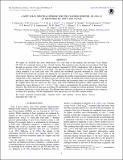A SOFT X-RAY SPECTRAL EPISODE FOR THE CLOCKED BURSTER, GS 1826–24 AS MEASURED BY SWIFT AND NuSTAR
Author(s)
Chenevez, J.; Galloway, D. K.; in ’t Zand, J. J. M.; Tomsick, J. A.; Barret, D.; Fürst, F.; Boggs, S. E.; Christensen, F. E.; Craig, W. W.; Hailey, C. J.; Harrison, F. A.; Romano, P.; Stern, D.; Zhang, W. W.; Chakrabarty, Deepto; ... Show more Show less
DownloadChenevez_2016_ApJ_818_135.pdf (761.4Kb)
PUBLISHER_POLICY
Publisher Policy
Article is made available in accordance with the publisher's policy and may be subject to US copyright law. Please refer to the publisher's site for terms of use.
Terms of use
Metadata
Show full item recordAbstract
We report on NuSTAR and Swift observations of a soft state of the neutron star low-mass X-ray binary GS 1826-24, commonly known as the "clocked" burster. The transition to the soft state was recorded in 2014 June through an increase of the 2-20 keV source intensity measured by MAXI, simultaneous with a decrease of the 15-50 keV intensity measured by Swift/BAT. The episode lasted approximately two months, after which the source returned to its usual hard state. We analyze the broadband spectrum measured by Swift/XRT and NuSTAR and estimate the accretion rate during the soft episode to be ≈13% [dot over m][subscript Edd], within the range of previous observations. However, the best-fit spectral model, adopting the double Comptonization used previously, exhibits significantly softer components. We detect seven type-I X-ray bursts, all significantly weaker (and with shorter rise and decay times) than observed pr eviously. The burst profiles and recurrence times vary significantly, ruling out the regular bursts that are typical for this source. One burst exhibited photospheric radius expansion and we estimate the source distance as (5.7 ± 0.2) ξ [superscript -1/2][subscript b] kpc, where ξ[subscript b] parameterizes the possible anisotropy of the burst emission. The observed soft state may most likely be interpreted as a change in accretion geometry at about similar bolometric luminosity as in the hard state. The different burst behavior can therefore be attributed to this change in accretion flow geometry, but the fundamental cause and process for this effect remain unclear. Key words: accretion, accretion disks – binaries: close – stars: neutron – X-rays: bursts – X-rays:
individual (GS 1826–24)
Date issued
2017-02Department
Massachusetts Institute of Technology. Department of Physics; MIT Kavli Institute for Astrophysics and Space ResearchJournal
The Astrophysical Journal
Publisher
American Astronomical Society
Citation
Chenevez, J., et al. “A SOFT X-RAY SPECTRAL EPISODE FOR THE CLOCKED BURSTER, GS 1826–24 AS MEASURED BY SWIFT AND NuSTAR.” The Astrophysical Journal, vol. 818, no. 2, Feb. 2016, p. 135. © 2016 The American Astronomical Society
Version: Final published version
ISSN
1538-4357
0004-637X